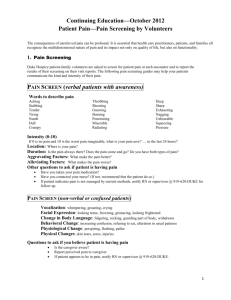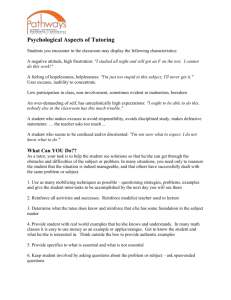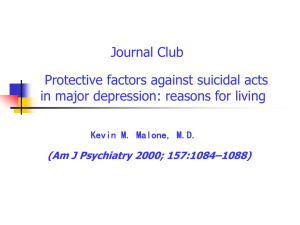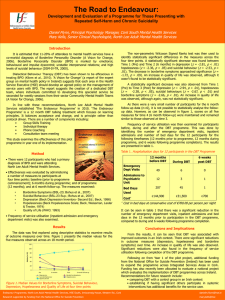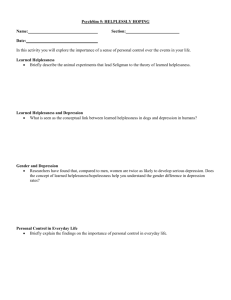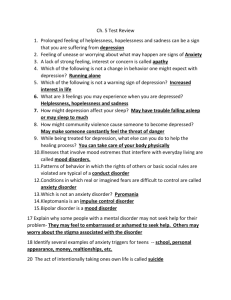Hopelessness: A Concept Analysis Paper
advertisement
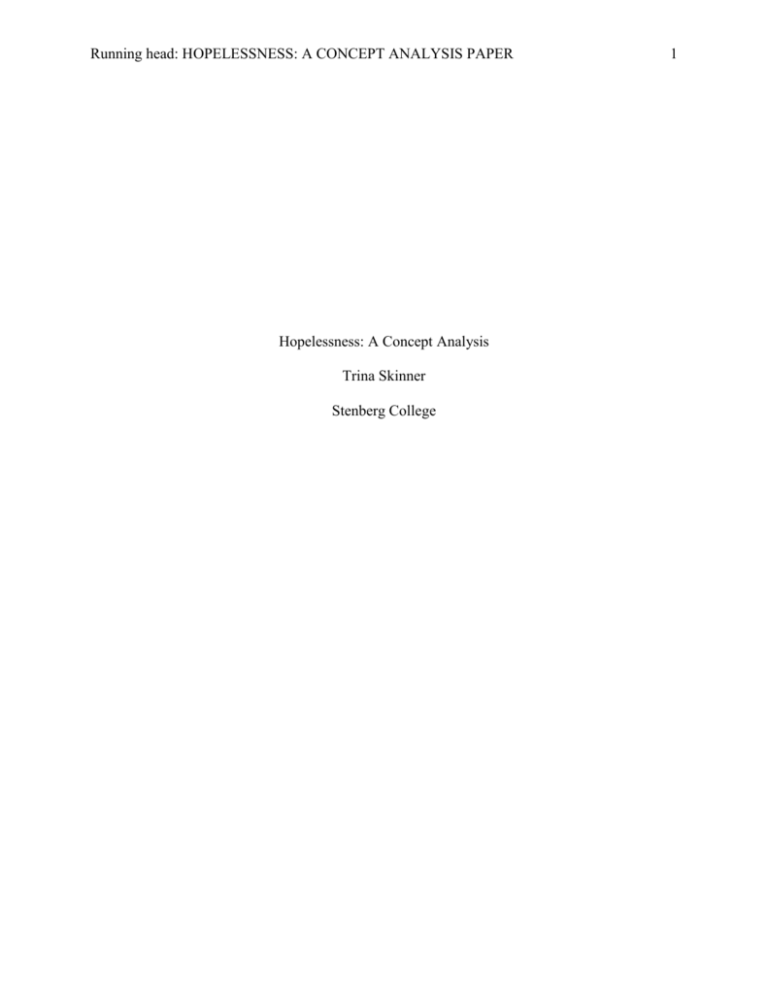
Running head: HOPELESSNESS: A CONCEPT ANALYSIS PAPER Hopelessness: A Concept Analysis Trina Skinner Stenberg College 1 HOPELESSNESS: A CONCEPT ANALYSIS PAPER 2 Hopelessness: A Concept Analysis The objective of this paper is to offer an analysis, “separation of a whole into its component parts” (Merriam-Webster, 2012) of the concept of hopelessness and the residual effects that a feeling of hopelessness may have on an individual’s psychological health. In deconstructing the concept of hopelessness this paper will address three defining characteristics of hopelessness. Hopelessness and depression, risk for suicidality, and insufficient or maladaptive coping skills are all examples of circumstances that create or exacerbate an environment that breeds hopelessness. Hopelessness can be defined as “a manner of thinking and feeling which frames life with negative perceptions of the present and bleak expectations about the future” (Barker, 2009, p. 184). A person experiencing feelings of hopelessness generally anticipates that there is no way for life to improve, upholding the belief that he or she is powerless in effecting any positive change. (Barker, 2009, p. 184). The nature of a hopeless person’s thought process and content is often of a very narrow manner. In attempt to provide a sufficient concept analysis of ‘hopelessness’ it is crucial that the reader is aware of the hopelessness theory of depression (Abramson et al, 1989). The theory suggests that “inferred negative consequences and negative characteristics about the self contribute to the formation of hopelessness, and in turn the symptoms of hopelessness contribute to depression” (Stuart, 2009, p. 289). This author explains that the hopelessness theory is thus closely linked to the cognitive model of depression. The cognitive model of depression “proposes that people experience depression because their thinking is disturbed” (Beck et al, 1979, as cited in Stuart 2009). According to Stuart (2009), “Depression is seen as a cognitive problem dominated by a person’s negative evaluation of self, the world, and the future” (p. 288). HOPELESSNESS: A CONCEPT ANALYSIS PAPER 3 Although one must express caution in potentially regarding hopelessness and depression as interchangeable terms, the relativity of this particular theory relies on the notion of feelings of hopelessness as a precursor to depression. In identifying common behaviors associated with depression, Stuart (2009), has separated these into four categories; affective, physiological, cognitive, and behavioral. Hopelessness, helplessness, apathy, and sense of personal worthlessness are some of the common examples of affective behaviors related to depression. Some of the notable cognitive behaviors of depression which offer evidence of the presence of hopelessness are ambivalence, loss of interest and motivation, pessimism, and self-destructive thoughts due to the strong belief that there is no conceivable way that life will improve and expectations for the future are dismal at best (p. 286). It is crucial that the psychiatric nurse be properly educated and maintains a high level of awareness regarding signs and symptoms of depression in assessing a person’s feelings of hopelessness. Social stigma must also be considered in regards to nursing intervention concerning hopelessness and depression. Some patients may deny feelings of hopelessness or depression and focus on identification of various somatic complaints as physical symptoms are more socially acceptable than those of a psychological nature (Stuart, 2009). In this case the nurse must be cognizant of what sort of physical symptoms and behaviors are associated with depression in order to assess the individual who is potentially struggling with feelings of hopelessness; offering encouragement to identify and bring these feelings to the forefront to be assessed and managed in an effective manner that enhances the person’s quality of life. Hopelessness in the depressed patient is extremely dangerous as the hopeless person is not only expressing depressed mood and behaviors but perseverates on the pessimistic view that life is unbearable and positive change is unfathomable. HOPELESSNESS: A CONCEPT ANALYSIS PAPER 4 It is imperative that the prudent nurse always assess the potential for suicide in individuals living with severe mood disturbances, such as hopelessness. In considering the risk for suicidality as a defining characteristic of persons affected by hopelessness, experience of a crisis is proven to generate feelings and thoughts of hopelessness that may lead to attempted or completed suicide. (Barker, 2009, p. 184). In examining personality traits and disorders related to suicidality, four aspects of personality “most closely associated with increased risk of suicide are hostility, impulsivity, depression, and hopelessness” (Dumais et al, 2005; Swann et al, 2005 as cited in Stuart, 2009, p. 318). A study conducted in 1994, Hope, hopelessness, and suicidality in college students, set out to “estimate the associations among measures of hope, hopelessness, and suicidality” (Range and Penton, 1994). Results were measured by a means of analyzing scores of 206 undergraduates attending the University of Southern Mississippi on surveys that include the “Reasons for living inventory”, the “Hopelessness scale, and the “Hope scale”. Not surprisingly the conclusion identified “significant correlations [indicating] that as hope is increased, hopelessness decreased. This conclusion emphasizes the importance of early detection of conceptual feelings of hopelessness in the clinical setting as a potential means of decreasing the risk for suicidality. Those who scored as relatively more suicidal had relatively fewer feelings of total hope...[and increased feelings of hopelessness]” (Range & Penton, 1994). Various studies consistently report hopelessness as a “key variable in linking depression to suicidal behavior” (Grewal & Porter, 2007; Hunter & O’Connor, 2003; Kuo, Gallo, & Eaton, 2004; MacLeod et al., 2005; Uncapher, Gallagher-Thompson, Osgood, & Bongar, 1998) as cited in (Sun, 2011, p. 460).“Grewal and Porter (2007) pointed out that hopelessness is found to correlate better with suicidal ideation than depression, and is more precise than depression in predicting eventual suicide” (Sun, 2011, p. HOPELESSNESS: A CONCEPT ANALYSIS PAPER 5 460). Findings indicate that individuals who had previously expressed hopelessness (1981)” were 11.2 times more likely to have completed suicide over the 13-year follow-up period than those who did not” (Kuo et al. (2004) as cited in Sun, 2011, p. 460). “When presented with a situational problem to solve, a person whose thoughts are hopeless and rigid may conclude that suicide is the only choice”. The hopeless person may view death as a means to an end, an opportunity to escape the pain experienced in life (Barker, 2010, p. 184). In terms of nursing intervention and selected rationales in the case of a person who is at risk for suicide as a result of hopelessness, it is crucial that the nurse establishes open and honest communication with the client, asking them outright “Have you thought about harming yourself in any way? If so what do you plan to do? Do you have the means to carry out this plan?” (Townsend, 2011, p. 129). Directly questioning the hopeless client about suicidal ideation will not result in the person taking suicidal action. On the contrary, “most patients will be relieved to be asked about these feelings” (Stuart, 2009, p. 318). Further effective intervention in the case of caring for a patient suffering from a state of hopelessness, Stuart (2009), emphasizes the importance “that nurses have a systematic way of evaluating a patient for the risk of suicide, preferably through the use of a standardized suicide assessment tool and safety plan” (p. 318). Finally, Townsend, 2011, reminds us that spending time with a client and expressing genuine concern for his or her wellbeing is the most important aspect in working with the client at risk for suicide as a result of hopelessness. “This provides a feeling of safety and security, while also conveying the message, ‘I want to spend time with you because I think you are a worthwhile person’” (p. 131). A final characteristic of hopelessness is the impact a lack of adequate coping skills and has on increased feelings of hopelessness within an individual. A person who is experiencing the conceptual feelings of hopelessness tends to think in extremely narrow terms (as presented HOPELESSNESS: A CONCEPT ANALYSIS PAPER 6 earlier), “This constriction in cognitive processes limits the range of understanding of situations and potential choices that may be available for problem resolution” (Barker, 2010, p. 184). In 2010, the Southern African Journal of HIV Medicine published an article based on the study, Feelings of Hopelessness in Stable HIV-Positive Patients on Antiretrovirals. According to conclusions drawn from this study, “the coping skills and styles individuals utilize to deal with the stress of HIV infection greatly influence the psychological impact of this illness and potential consequent feelings of hopelessness” (Moosa & Joonah, 2010). Although this study focuses strictly on people living with HIV it is reasonable to deduce that an inventory of one’s coping skills, based on effectiveness, therapeutic value, ability to access such skills, and willingness to put healthy adaptive coping skills to use is applicable to all individuals living with any illness or disorder that has the potential to compromise the quality of that persons mental health. Maladaptive coping skills most certainly correlate with increased feelings of hopelessness and depression in individuals already experiencing such debilitating states of altered perception. “This small study suggests that hopelessness may be a common psychological distress reaction…” The creators of this study recommend that the healthcare community “become aware of this possibility and use the BHS [20-item Beck’s Hopelessness Scale] as a screening tool to identify such individuals and refer them for basic psychotherapy to improve coping skills and reduce feelings of hopelessness. The hopelessness theory proposes that it is not a trauma itself that produces depression, but the belief that one has no control over the important outcomes in life and therefore refrains from adaptive responses” (Seligman, 1975 as cited in Stuart, 2009, p. 289). In situations where a patient is suffering from the effects of hopelessness it is imperative that the psychiatric nurse providing care is well educated and experienced in providing therapeutic treatment that focuses on the development and implementation of effective coping HOPELESSNESS: A CONCEPT ANALYSIS PAPER 7 skills. It is of critical importance that the nurse “Encourage verbalizations of honest feelings”. Through exploration and discussion, the nurse is able to assist the client in identifying “symbols of hope in his or her life” (Townsend, 2011, p. 128). During discussion with a client experiencing feelings of hopelessness, it is important that the nurse become aware of situations in which a sense of powerlessness or lack of control is communicated by the client. The nurse may intervene by focusing on these perceived feelings, which in itself may assist the client in regaining a feeling of control or power over his/her circumstance. “A sense of self-worth develops and is maintained when an individual feels power over his or her own life situations” (Townsend, 2011, p. 268). In conclusion, hopelessness is a concept with far reaching implications within the context of mental health. Hopelessness and depression, risk for suicidality, and a lack of effective coping skill are three defining characteristics of the concept of hopelessness. It is imperative that a competent and effective nurse in the psychiatric setting consider the effects and implications of hopelessness in the psychologically disturbed client as a serious health deterrent, and should therefore devise and put into practice an individual care plan taking the concept of hopelessness into consideration when doing so, as a means of orchestrating the most relevant, effective and caring approach to enhance the quality of a client’s holistic health and wellbeing. Modes of intervention when considering the concept of hopelessness within the nursing process should be multi-faceted, innovative, and detailed in order to address all causal factors associated with a client’s diagnoses. A thorough comprehension of all aspects of hopelessness is necessary in determining the most effective treatment modalities based on the clients individual needs. The planning and implementation of nursing interventions surrounding the concept of hopelessness first begins with the formation of a therapeutic relationship between nurse and client in which HOPELESSNESS: A CONCEPT ANALYSIS PAPER 8 trust, respect, honesty, acceptance, and effective communication are paramount. Once a healthy therapeutic relationship has been established, the nurse and client can seek out possible treatment modalities in helping the person reduce feelings of hopelessness and hopefully regain a will to live. Cognitive behavioral therapy, or other forms of group therapy that focus on restructuring the disturbed thought process would likely be beneficial to a person suffering from hopelessness. In some cases certain psychotropic medications used to treat depression may be necessary. If anti-depressant medication is determined to be a reasonable intervention for a client, it should be implemented in conjunction with psychotherapy. It is important to treat the underlying cause of the person’s sense of hopelessness, simply prescribing medication with no opportunity to explore and reframe one’s destructive thought patterns will only produce a ‘band-aid effect’ addressing the symptoms without offering an opportunity for the person to reflect on and gain knowledge of where this sense of hopelessness stems from in order to be able to better manage instances of such feelings in the future. “Therapeutic relationships are the cornerstone of nursing practice with people who are experiencing threats to their health” (Barker, 2009, p. 313), this principle undoubtedly applies to the concept of hopelessness. HOPELESSNESS: A CONCEPT ANALYSIS PAPER 9 References Barker, P. (Ed.). (2009). Chapter 21: The person who is suicidal. Psychiatric and mental health nursing: The craft of caring (2nd ed., pp. 182-190). London, UK: Hodder Arnold. Moosa, M. Y., & Jeenah, F. Y. (2010). Feelings of hopelessness in stable HIV-positive patients on antiretrovirals. The South African journal of HIV medicine. Department of Psychiatry, University of the Witwatersrand, Johannesburg Retrieved from http://www.google.ca/url?sa=t&rct=j&q=&esrc=s&source=web&cd=2&ved=0CD0QFjA B&url=http%3A%2F%2Fwww.ajol.info%2Findex.php%2Fsajhivm%2Farticle%2Fdownl oad%2F70084%2F58213&ei=S27yUNXTCcHviQK5poHgAg&usg=AFQjCNGvWODa LTli1CfLCv-PWC8fRLHPmA&bvm=bv.1357700187,d.cGE Range, L. M., & Penton, S. R. (1994). Hope, hopelessness, and suicidality in college students. Psychological reports. 75(1 Pt. 2): 456-458. Retrieved from http://www.ncbi.nlm.nih.gov/pubmed/7809317 Stuart, G. W. (2009). Principles and practice of psychiatric nursing (9th ed.). St. Louis, MI: Tom Wilhelm. Sun, F. (2011). A Concept Analysis of Suicidal Behavior. Public Health Nursing, 28(5), 458468. doi:10.1111/j.1525-1446.2011.00939.x Townsend, M. C. (2011). Nursing diagnoses in psychiatric nursing: Care plans and psychotropic medications (8th ed.). Philadelphia, PA: F.A. Davis Company.



